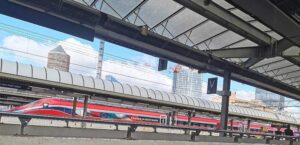Does Wayland becoming the defacto standard display server for Linux serve to marginalize BSD?
Like most people who use Linux as their daily driver, I’ve been pleased lately to see that Wayland is finally getting some serious traction and is on its way to being the default display server for most mainstream Linux distributions.
It’s been a long trip from the days when we first heard that X was on its way out and that Wayland was on its way in — 15 years as a matter of fact — so the better performance, more svelte code base, enhanced security, and all of the other advantages that Wayland brings to the table being just about here for some of us, and already here for others, is indeed good news.
But before we pop the cork on the champagne bottles and start the celebrations, perhaps we should consider that this good news for Linux might not be good news for those running BSD or one of the Unixes, which is something that normally would never occur to me to think about since I’ve never tried to use BSD. The only reason I’m thinking about it now is because this weekend I ran across a post by Chris Siebenmann, a Unix systems administrator at the University of Toronto’s CS Labs.
Being a Unix guy by day (and I suspect a BSD guy by night), he’s all on what Wayland on Linux means to BSD/Unix stuck on X, and he’s been thinking about what Linux’s move to Wayland is going to mean for desktop BSDs and Unixes.
“Once upon a time, the future of Unix desktops looked fairly straightforward,” he wrote. “Everyone ran on X, so the major threat to cross-Unix portability in major desktops was the use of Linux only APIs, which became especially D-Bus and systemd related things. Unix desktops that were less attached to tight integration with the Linux environment would probably stay easily available on FreeBSD, OpenBSD, and so on.”
The main thing I got from that is that for a long time, the BSDs have benefited somewhat from Linux. In this case, because both operating systems use X, it was relatively easy (“relatively” probably being the key word here) to port most popular “Linux” desktop environments to BSD. The trouble is, according to Siebenmann, those days might be coming to an end.
“What happened to this nice simple vision was Wayland becoming the future of (Linux) graphics,” he said. “Linux is the primary target of KDE and especially Gnome, so Wayland being the future on Linux has gotten developers for Gnome to start moving toward a Wayland-only vision. Wayland is unapologetically not cross-platform the way X was, which leaves other Unixes with a problem and creates a number of possible futures for Unix desktops.”
Remember, in the BSD world all of the different operating systems have pretty small volunteer developer teams. There are no Red Hats, SUSEs, or Ubuntus that employ hundreds if not thousands of software engineers to develop and maintain systems. It’s not much different with the commercial Unixes. Yes, IBM, Hewlett Packard Enterprise, and Oracle all spend big bucks to employ staff to continue to develop and maintain AIX, HP-UX, and Solaris for their shrinking user bases, but you can bet your sweet bippy they’re not going to spend a penny developing display server technology — not for operating systems that mainly run headless in data centers.
Siebenmann’s BSD Futurescape
The future that Siebenmann paints of BSD’s future from a graphical standpoint isn’t necessarily bleak, but it does sometimes read somewhat like a dystopian science fiction description of order devolving into something less than it was. BSD continues to use tried and true X, the platform that all of the Linux desktops will eventually abandon as Wayland becomes the standard used by all but a few retro distros (in much the same way that systemd has become the Linux standard, although systemdless distros such as Devuan continue to exist for the old-timers resistant to change).
According to this scenario, eventually BSD interfaces will be more like windows managers than full-fledged desktops.
“There are people, me included, who would be more or less happy with this state of affairs,” Siebenmann said. “I suspect that this is the path that OpenBSD will stick with, and my guess is that anyone using OpenBSD for their desktop or laptop environment will be happy with this.”
However, that’s only one potential future for the Unix/BSD desktop that he sees. For example, through the implementation of APIs and stuff (pardon the technical term), Wayland could be made functional, meaning BSD could continue to support mainstream Linux desktops such as KDE and Gnome.
“I believe that FreeBSD is working on this approach, although I don’t know if Gnome on Wayland on FreeBSD works yet,” Siebenmann said. “This allows the other Unix to mostly look like Linux, desktop-wise. As an additional benefit, it allows the other Unix to also use other, more minimal Wayland compositors that people may like, such as Sway (the one everyone mentions).”
Christine Hall has been a journalist since 1971. In 2001, she began writing a weekly consumer computer column and started covering Linux and FOSS in 2002 after making the switch to GNU/Linux. Follow her on Twitter: @BrideOfLinux








How close is Wayland to replace X in Linux? My understanding is that it is lacks a number of features that are crucial to many current users. Is that not true any longer?
I don’t think it’s entirely fair to describe people reluctant to use Wayland or sysemd on their desktop computers as simply “old-timers resistant to change.” There are legitimate reasons not to use either.
In Wayland’s case, I have yet to see any hard evidence that it’s really “more performant” (and I don’t have performance issues with X11 in my environment either, so I’m not sure I would care even if I did see some). The security features it offers are only arguably desirable; they break various features of X11 you might actually want instead. For instance, you can make a small X application that works like a little magnifying glass and enlarges text near the mouse. This will work in any X environment regardless of which WM or compositor you might be using. In Wayland, it’s not possible to make an application like that which will work anywhere—you have to depend on your DE for something like that. Likewise, with X11, the WM and compositor are decoupled, and the compositor is a small component you can write yourself; you can use this to implement unique graphical effects either per-window or across your desktop that will work with any WM that doesn’t also do compositing (which includes many X11 WMs). I’m working on a custom X11 compositor that can detect and smudge out flashing light patterns so they don’t give me migraines; my hope is that this will also be useful to photosensitive epilsepy suffers. To do this in Wayland, I would have to write an entire new DM from the ground up, which would be senseless just for a small compositing effect. I have no idea why people want this as the new status quo aside from the fact that Red Hat, GNOME, etc. are pushing it, and I wish more people would think critically about it.
I’m all for change in the Linux ecosystem when it’s positive and implemented responsibly. For example, the new nftables firewall in the kernel is a great replacement for iptables—it’s backwards-compatible with iptables, but also offers a new, friendlier syntax you can use instead, and has extra features beyond what iptables provides. If Wayland was like that with regards to X11, I would be using it already. As it is, the sidelining of the BSDs is just one more reason to be skeptical of it.